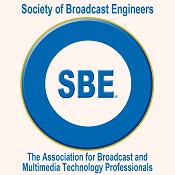
|
|
 CHAPTER 24, Inc., MADISON, WI |
- Home
- Meetings
Schedule - Meeting
Minutes - Chapter
By Laws - Chapter
Officers -
Technical
Documents -
EAS
Info -
Chapter
Archives - Sustaining
Members -
Broadcasters
Clinic - DTV for
Consumers - Links
THE POLAR MOUNT IN THE STUDY OF ASTRONOMYby Neal McLain, CSBEThe two pointing-angle measurement systems discussed in Part 4 have been used for centuries in the fields of navigation and astronomy. Navigators need to determine the latitude and longitude positions of their vessels. For this purpose, the azimuth/elevation system works best. The classic image of the 19th-Century British Admiral shows him "shooting the sun" with a sextant; the sextant is simply an instrument for measuring elevation. By measuring the elevation of the sun at local noon, and referring to a set of published tables called an ephemeris, a navigator can determine his position with great precision. Astronomers, on the other hand, need to determine the position of astronomical objects in the sky. For this application, they prefer polar measurements (hour angle and declination). The reason: the declination angle to a star is independent of time and date. For example, the bright star Sirius is at declination -16°; i.e., it is located 16° south of the Celestial Equator. Like every other star, it rises in the east and sets in the west, but it always remains at declination -16°. Even before the invention of the telescope, this system of measurements was used by astronomers. This system greatly simplifies the preparation of ephemeris tables, because only hour angle must be tabulated. With the invention of the telescope in the early 1600s, polar measurements took on new importance: in order to study a star, it is necessary to track it. Thus, the telescope had to be fitted with a tracking mechanism. This simplest star-tracking mechanism is, of course, a polar mount: declination is fixed, and only hour angle must be moved. The name of the inventor of the polar mount has been lost in history. But it seems likely that the Italian astronomer and mathematician Galileo Galilei (1564-1642) must have constructed at least one. Contrary to popular legend, Galileo did not actually invent the telescope, but he constructed many telescopes for his own use, and he made many improvements in their design. In the course of this work, he must have designed many supporting mechanisms. In modern astronomy, the polar mount is more commonly called an "equatorial" mount. Most equatorial mounts are fitted with motorized tracking mechanisms which move the telescope to compensate for motion of the earth. It should be noted that even an equatorial mount won't track objects within our own solar system: the sun, the moon, and the planets. These objects don't have fixed declination angles; instead, they appear to wander around, each according to its own orbit. Nonetheless, an equatorial mount follows them more closely than an EL/AZ mount. And finally, a more recent phenomenon should be noted: in this age of computerized control systems, there's been a shift to EL/AZ mounts even for astronomical instruments. Modern "ephemeris-on-a-chip" control systems can calculate azimuth and elevation angles so rapidly that an EL/AZ mount can track a star as accurately as an equatorial mount. Moreover, these systems can track other objects as well: sun, moon, planets, asteroids, and comets. -------------------Further readings: • Telescopes and Astronomy: Frequently Asked Questions from Meade Instruments Corporation, Irvine, CA, USA. • Celestial Navigation Net. • Columbus and Celestial Navigation • Photo Gallery: Polar (Equatorial) Mounts • Photo Gallery: EL/AZ (ALT/AZ) Mounts • Photo Gallery: Meridian Telescope Mounts Orbits Index Page |